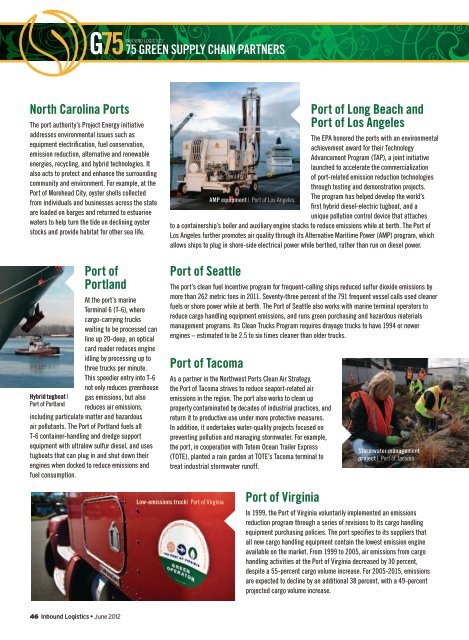75 GREEN SUPPLY CHAIN PARTNERS
75 GREEN SUPPLY CHAIN PARTNERS
75 GREEN SUPPLY CHAIN PARTNERS
Create successful ePaper yourself
Turn your PDF publications into a flip-book with our unique Google optimized e-Paper software.
North Carolina Ports<br />
The port authority’s Project Energy initiative<br />
addresses environmental issues such as<br />
equipment electrifi cation, fuel conservation,<br />
emission reduction, alternative and renewable<br />
energies, recycling, and hybrid technologies. It<br />
also acts to protect and enhance the surrounding<br />
community and environment. For example, at the<br />
Port of Morehead City, oyster shells collected<br />
from individuals and businesses across the state<br />
are loaded on barges and returned to estuarine<br />
waters to help turn the tide on declining oyster<br />
stocks and provide habitat for other sea life.<br />
Hybrid tugboat |<br />
Port of Portland<br />
Port of<br />
Portland<br />
At the port’s marine<br />
Terminal 6 (T-6), where<br />
cargo-carrying trucks<br />
waiting to be processed can<br />
line up 20-deep, an optical<br />
card reader reduces engine<br />
idling by processing up to<br />
three trucks per minute.<br />
This speedier entry into T-6<br />
not only reduces greenhouse<br />
gas emissions, but also<br />
reduces air emissions,<br />
including particulate matter and hazardous<br />
air pollutants. The Port of Portland fuels all<br />
T-6 container-handling and dredge support<br />
equipment with ultralow sulfur diesel, and uses<br />
tugboats that can plug in and shut down their<br />
engines when docked to reduce emissions and<br />
fuel consumption.<br />
46 Inbound Logistics • June 2012<br />
INBOUND LOGISTICS’<br />
<strong>75</strong> <strong>GREEN</strong> <strong>SUPPLY</strong> <strong>CHAIN</strong> <strong>PARTNERS</strong><br />
Port of Seattle<br />
Port of Long Beach and<br />
Port of Los Angeles<br />
The EPA honored the ports with an environmental<br />
achievement award for their Technology<br />
Advancement Program (TAP), a joint initiative<br />
launched to accelerate the commercialization<br />
of port-related emission reduction technologies<br />
through testing and demonstration projects.<br />
AMP equipment | Port of Los Angeles<br />
The program has helped develop the world’s<br />
fi rst hybrid diesel-electric tugboat, and a<br />
unique pollution control device that attaches<br />
to a containership’s boiler and auxiliary engine stacks to reduce emissions while at berth. The Port of<br />
Los Angeles further promotes air quality through its Alternative Maritime Power (AMP) program, which<br />
allows ships to plug in shore-side electrical power while berthed, rather than run on diesel power.<br />
The port’s clean fuel incentive program for frequent-calling ships reduced sulfur dioxide emissions by<br />
more than 262 metric tons in 2011. Seventy-three percent of the 791 frequent vessel calls used cleaner<br />
fuels or shore power while at berth. The Port of Seattle also works with marine terminal operators to<br />
reduce cargo handling equipment emissions, and runs green purchasing and hazardous materials<br />
management programs. Its Clean Trucks Program requires drayage trucks to have 1994 or newer<br />
engines – estimated to be 2.5 to six times cleaner than older trucks.<br />
Port of Tacoma<br />
As a partner in the Northwest Ports Clean Air Strategy,<br />
the Port of Tacoma strives to reduce seaport-related air<br />
emissions in the region. The port also works to clean up<br />
property contaminated by decades of industrial practices, and<br />
return it to productive use under more protective measures.<br />
In addition, it undertakes water-quality projects focused on<br />
preventing pollution and managing stormwater. For example,<br />
the port, in cooperation with Totem Ocean Trailer Express<br />
(TOTE), planted a rain garden at TOTE’s Tacoma terminal to<br />
treat industrial stormwater runoff.<br />
Low-emissions truck| Port of Virginia<br />
Port of Virginia<br />
Stormwater management<br />
project | Port of Tacoma<br />
In 1999, the Port of Virginia voluntarily implemented an emissions<br />
reduction program through a series of revisions to its cargo handling<br />
equipment purchasing policies. The port specifi es to its suppliers that<br />
all new cargo handling equipment contain the lowest emission engine<br />
available on the market. From 1999 to 2005, air emissions from cargo<br />
handling activities at the Port of Virginia decreased by 30 percent,<br />
despite a 55-percent cargo volume increase. For 2005-2015, emissions<br />
are expected to decline by an additional 38 percent, with a 49-percent<br />
projected cargo volume increase.


